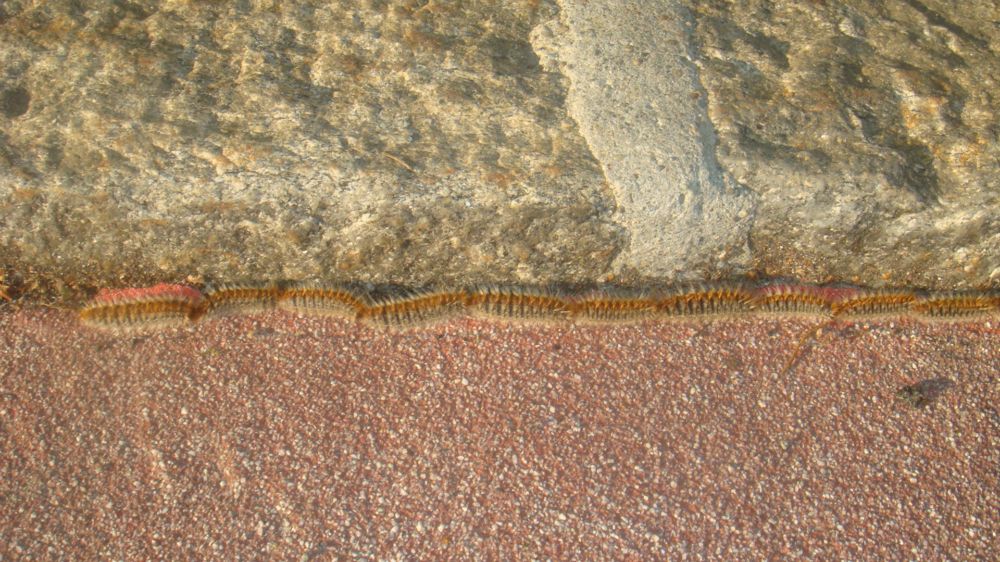.I knew nothing about these creatures before moving to Switzerland. The first I learnt about them was when a friend developed a skin rash because of them.
What are marching caterpillars?
Marching caterpillars are usually somewhere between 3 and 4 centimetres long and they’re covered with thousands and thousands of pointed hairs. There are two types: pine and oak. The pine marching caterpillars have a darker body. You can clearly see the hairs sticking out from their body and you can see a rusty colour running along their back. The oak marching caterpillars again have a darker body but this time you can see a slightly yellower colour running along their back.
They’re called ‘marching caterpillars’ because they literally move along in single file behind each other – in a procession. In fact, they’re also known as ‘processionary caterpillars’, so you might have heard that term as well. In French, they’re called ‘chenilles processionnaires’.
If you’re interested in their life cycle, what happens is that the Pine and Oak Processionary moths lay their eggs during the Summer months. They lay them on twigs and small branches in the tree canopy. The eggs stay there over winter (they have a protective layer to protect them from the cold weather). Then the larvae start to hatch from the eggs in the Spring. The larvae are the caterpillars.
When are the caterpillars on the march?
The caterpillars are highly active during the Spring and Summer. They live in the Pine and Oak trees and form colonies, creating large nests in the trees that look a bit like cobwebs or candy floss. It’s when they’ve run out of the food from the tree that they’re living in that they come down from the tree, all at once, all together in a long single file, following each other head-to-tail. They’re basically on the move to find another tree to set up camp in, looking for somewhere to pupate (to go through their pupal stage so that they can transform – undergo metamorphosis – into their adult form, the moth).
So, you can often see the caterpillars marching along in their single file procession and they can cover large distances along the ground.
The caterpillars mature and develop over a period of about 9 to 12 weeks and they pupate inside their nests during the end of June/beginning of July and the adult moths emerge 1 to 2 weeks later. They lay their eggs and the life cycle is completed.
What problems do marching caterpillars have for humans?
So what problem can they cause for humans? The problem is that the caterpillars are covered in hairs and these hairs contain a toxin that is highly irritating to humans. The hairs can break off from the caterpillars very easily and can become airborne easily as well – they can be carried on the wind. If your skin comes into contact with the hairs, then they can cause an irritating, itchy skin rash. It’s like small, red, slightly swollen bumps on the skin. It might only last for a few hours but sometimes the skin rash can become scaly and eczema-like and last for a few weeks. If you breathe in some of the airborne hairs, then this can lead to breathing problems – wheezing, and difficulty breathing, particularly in people who already suffer from asthma. And the hairs can irritate the eyes causing an irritant conjunctivitis – irritation, itchiness and redness of the eyes.
What are the symptoms?
The degree of symptoms can vary from person to person. Not everyone who comes into contact with the caterpillar hairs will develop symptoms. Some people don’t have any problems at all. They don’t react to the hairs. The most common problem is the itchy rash. Yes, it’s unpleasant but it’s not serious or life-threatening. However, if someone already has asthma and they inhale the hairs, then there is the potential to spark off an asthma attack which can be severe in some people. And I believe that a severe allergic reaction (an anaphylactic reaction) has been triggered in some people who have come into contact with the caterpillar hairs.
If you come across the caterpillars in a tree, or on the move in their procession, you should try to stay away from them as much as possible. Avoid the area. And avoid any trees where you can see the cobweb or candy floss like nests. If you see the caterpillars on the ground, certainly don’t handle them in any way.
What about pets?
And keep children and pets away as well. Explain about the caterpillars to your children. Teach them to stay away if they see them. They’re probably quite attractive, interesting-looking creatures to children – who love picking up creepy crawlies when they’re out and about exploring. Find a picture on the internet to show them so that they know what to look out for. Tell them not to touch them or go near them.
Contact your commune to get a nest removed if you see that there is a colony in one of the trees in your garden. DO NOT try to get rid of the nest yourself. Even when nests are empty, they can still contain large amounts of the caterpillar hair and that’s the toxic stuff. They’re full of hair because the larvae (the caterpillars) moult inside the nest, casting off their skin and their hairs, causing them to accumulate. If you try to knock down or disturb a nest, this makes the hairs airborne and easy to inhale.
What should I do if I come into contact with marching caterpillars?
If your skin does come into contact with the caterpillars or their hairs, then you need to remove them as soon as possible. If available, put on a pair of gloves to protect the skin of your hands whilst you’re doing this. And I would suggest washing your hands and the affected area of skin with copious amounts of soap and water. Treat any rash with antihistamines – either in cream or tablet form. Go and discuss the rash with a local pharmacist, or of course, see your doctor if you’re worried.
What to do if you think you have inhaled some of the hairs and you develop breathing difficulties? Anyone known to have asthma already should always carry their reliever inhaler with them when they’re out-and-about. This is an inhaler containing a drug that helps to dilate up the airways and so help relieve the wheezing and breathing symptoms. So, if you have a salbutamol inhaler prescribed already, then take it. If you don’t already have an inhaler prescribed, then it depends on how severe your symptoms are. Obviously, anyone with very severe symptoms should see a doctor or they may even need to call an ambulance in extreme cases. Then, medication can be given by the doctor to help relieve the wheezing and breathing problems.
So, marching caterpillars – what they look like, why you need to stay away from them and what to do if you haven’t managed to!
Join us for one of our first aid courses where you can learn how to deal with medical emergencies and day-to-day accidents.
Written by Dr Michelle Wright







